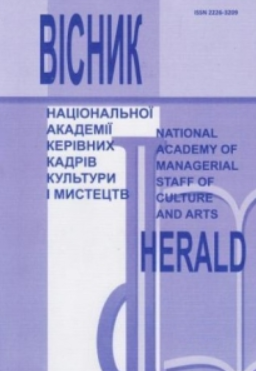СТРУКТУРНІ КОМПОНЕНТИ ІНФОТЕЙНМЕНТУ: ІНФОРМАЦІЙНА ТА РОЗВАЖАЛЬНА ПАРАДИГМИ
STRUCTURAL COMPONENTS OF INFOTAINMENT: INFORMATION AND ENTERTAINMENT PARADIGMS
Author(s): Kristina ChornaSubject(s): Media studies, Sociology of Art, History of Art
Published by: Національна академія керівних кадрів культури і мистецтв
Keywords: entertainment; information; infotainment; television; hedonism; game;
Summary/Abstract: The purpose of the article is to investigate, generalize, concretize, and compare the meaning of information and entertainment as the basic categories of the art history analysis of infotainment. Methodology. According to the purpose of the study, methods of a general theoretical nature were applied, in particular, methods of analysis, induction, and deduction, a method of synthesis, a phenomenological method that helped fix information and entertainment as phenomena, their reflective analysis and comprehensive comprehension in the context of the designated topic; and the methods of contemporary art history: to consider the structural components, methods, and functions of infotainment as a phenomenon of television art, to study the paradigms of entertainment and information in television programs, the method of art history analysis was applied; the comparative method helped to compare the specifics of the use of entertainment in television programs of the 20th century and at the present stage. Scientific novelty. Information and entertainment are investigated as the main structural components of infotainment. The theories of the game (R. Ortega, J. Huizinga, V. Stevenson) are extrapolated to the theory of entertainment in infotainment and it is revealed that the perception of materials offered by the media allows the recipients, as participants in the game, which takes place within spatial and temporal boundaries in accordance with their own laws, principles, and rules, to avoid social control and rules of the real world, as well as gain fictitious experience, which can later be transferred into real life; the viewer is a recipient for the sake of participation itself since he does not pursue additional goals, feeling a part of what he is watching; the viewer is immersed in the reality created by television, being guided in the maelstrom of various proposals for what meets his expectations. Conclusions. As a result of the conceptualization of information and entertainment as the basic categories of the art history analysis of infotainment, it has been revealed that the main intentions of mass consciousness at the present stage are aimed at hedonism and the symbolic transformation of the values of mass culture. Hedonism is a leading trend in modern television as a phenomenon of a mass culture focused on the viewer, on his desire to move away from problems: the accessibility of presentation of material, syncretism and magnetic audiovisual attractiveness greatly simplify the viewer's perception of not only news but information from any branch of human activity.
Journal: Вісник Національної академії керівних кадрів культури і мистецтв
- Issue Year: 2020
- Issue No: 4
- Page Range: 203-209
- Page Count: 7
- Language: Ukrainian

